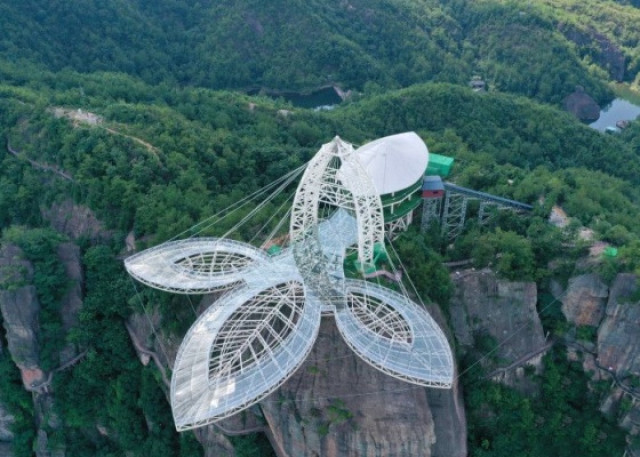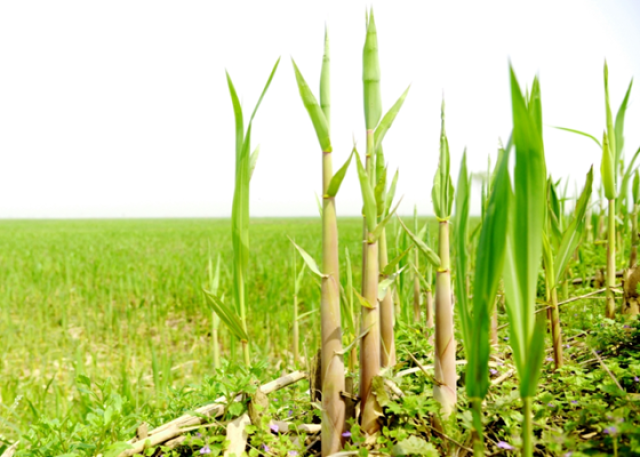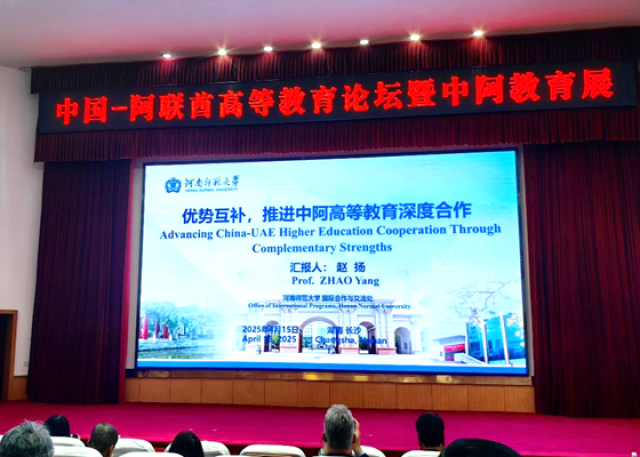給三百年湖南古樹“做手術(shù)”是為了……

A camphor tree in Xinyuan Village of Hengshan County, central China's Hunan Province, stood strong for three centuries before it began to falter in recent years.
中國(guó)湖南省衡山縣新源村里,一棵古樟樹歷經(jīng)三百年風(fēng)雨,,卻在近年逐漸“病弱”。
When Wu Lei, a specialist in ancient tree conservation, arrived in the village, he had a surgical plan and hoped that the giant tree could be returned to its prime.
古樹名木保護(hù)專家吳磊手握一套“手術(shù)方案”來訪,,希望能讓這棵蒼天大樹重?zé)ㄉ鷻C(jī),。
After cordoning off the area around the tree, Wu and another worker ascended into its canopy on a crane. There, they trimmed dead and dying branches with a chainsaw and carefully sealed exposed cuts with a wound-healing paste.
在樹周區(qū)域進(jìn)行隔離后,吳磊和另一名工人乘坐吊車升至樹冠處,,用電鋸修剪掉枯枝,并小心在裸露的切面涂抹傷口愈合劑,。
Beneath them, other workers drilled through the surrounding concrete and injected nutrients 3 meters deep into the ground every half hour to reach the tree's struggling roots.
樹下,,其他工人鉆開周圍的水泥地面,以每半小時(shí)1次的頻率,,向地下3米的深處為古樹根系輸送肥料和營(yíng)養(yǎng)劑,。
A handful of village locals gathered quietly in a nearby courtyard to watch the tree surgery unfold.
幾名村民靜靜聚集在遠(yuǎn)處的院子里,注視著這臺(tái)“手術(shù)”的進(jìn)行,。
The tree's decline began in 2021, when the construction of a nearby flood-control embankment compacted much of its root system, straining its ability to absorb water and nutrients.
這棵樹的“病弱”始于2021年,,當(dāng)時(shí)修建附近的防洪堤壩時(shí)壓迫到了其大部分根系,導(dǎo)致養(yǎng)分,、水分輸送嚴(yán)重受阻,。
"We see classic symptoms of crown dieback like yellow leaves, early leaf loss and bare skeletal branches," said Wu, deputy director of the ancient tree conservation and research center at the Central South University of Forestry and Technology.
“我們觀察到典型的樹冠枯萎癥狀,如葉片發(fā)黃,、提前落葉和枝干光禿,。” 中南林業(yè)科技大學(xué)古樹名木保護(hù)工程研究中心副主任吳磊表示,。
Without treatment, the camphor tree would likely have died within two to three years, said Deng Shicheng, head of the landscaping team assisting with the restoration efforts.
參與修復(fù)工作的綠化團(tuán)隊(duì)負(fù)責(zé)人鄧詩成表示,,若不進(jìn)行救治,這棵樟樹很可能會(huì)在2到3年內(nèi)死亡,。
"To heal an ancient tree, you have to begin with how it 'feels,'" Wu said. "Just like people, trees can suffer from overtreatment or mistreatment."
“救治古樹,,必須從樹的‘感受’出發(fā)。它們和人一樣,,也面臨過度治療和錯(cuò)誤治療的風(fēng)險(xiǎn)與傷害,。”吳磊說,。
The restoration was initiated by the county's forestry bureau in March and underwent a full review before approval.
此次修復(fù)由衡山縣林業(yè)局于3月發(fā)起,,經(jīng)全面評(píng)估后獲批實(shí)施。
Ancient trees can decline due to both human activity and natural causes, such as lightning strikes or insect infestations. Each year, forestry departments across Hunan assess the health of registered ancient trees. Simpler treatment plans are handled locally, while complex or severe cases are referred to provincial experts like Wu.
古樹生病既有類似的人為因素,,也有雷擊或蟲害等自然因素,。每年,湖南各地林業(yè)部門都會(huì)記錄轄區(qū)內(nèi)在編古樹的健康狀況,較簡(jiǎn)單的病情由地方處理,,復(fù)雜或嚴(yán)重的案例則會(huì)交由吳磊等省級(jí)專家介入,。
Hunan is home to around 240,000 registered ancient or notable trees. As of last year, the province had rescued nearly 4,000 endangered trees and revitalized another 30,000 in decline.
湖南省掛牌登記的古樹名木約有24萬棵。截至去年,,湖南全省已累計(jì)搶救瀕危古樹約4000棵,,復(fù)壯衰弱古樹約30000棵。
This year, officials aim to digitize the records of each tree and organize 200 public education events to raise awareness and encourage broader participation, according to Ou Riming, an official of the provincial forestry department.
湖南省林業(yè)局調(diào)研員歐日明介紹,,湖南省計(jì)劃今年實(shí)現(xiàn)掛牌登記的古樹名木信息數(shù)字化,,并組織科普宣傳活動(dòng)200場(chǎng),提升保護(hù)意識(shí),、讓更多人參與古樹名木的保護(hù),。
Hunan's efforts are part of a national campaign to protect ancient and notable trees. The former are defined as those that are over 100 years old, and the latter as those with historical, cultural or ecological importance.
湖南的行動(dòng)是全國(guó)古樹名木保護(hù)行動(dòng)的一部分。古樹是指樹齡超過100年的樹木,,名木則指具有歷史,、文化或生態(tài)價(jià)值的樹木。
In Beijing, experts conduct regular checkups of the ancient trees lining the city's UNESCO-listed Central Axis. In Chengdu, southwest China, a team of tree doctors formed in 2014 has assessed thousands of ancient trees citywide.
在北京,,專家會(huì)定期為列入聯(lián)合國(guó)教科文組織世界遺產(chǎn)的城市中軸線沿線古樹進(jìn)行“體檢”,;在成都,一支成立于2014年的“古樹醫(yī)生”團(tuán)隊(duì)已為全市數(shù)千棵古樹進(jìn)行了檢測(cè)評(píng)估,。
In January, China introduced its first national-level regulations to protect ancient and notable trees, aligning with the country's broader goals of building an ecological civilization and preserving cultural identity.
今年1月,,為推進(jìn)生態(tài)文明建設(shè)、傳承文化遺產(chǎn),,中國(guó)出臺(tái)了首部國(guó)家級(jí)古樹名木保護(hù)條例,。
A national survey conducted from 2015 to 2021 identified 5.08 million ancient or notable trees across China.
2015—2021年全國(guó)古樹名木資源普查結(jié)果顯示,中國(guó)共有508萬株古樹名木,。
The full rehabilitation of the camphor tree in Hunan is expected to take about a year and cost 30,000 yuan (about 4,163 U.S. dollars).
湖南這棵古樟樹的整個(gè)復(fù)壯過程預(yù)計(jì)持續(xù)1年時(shí)間,,復(fù)壯所需花費(fèi)達(dá)3萬元(約合4163美元)。
The team will continue providing follow-up care, including fertilization and pruning, while training locals in long-term maintenance.
相關(guān)團(tuán)隊(duì)將持續(xù)提供后續(xù)養(yǎng)護(hù),,包括施肥,、修枝等,同時(shí)培訓(xùn)當(dāng)?shù)卮迕襁M(jìn)行長(zhǎng)期維護(hù),。










